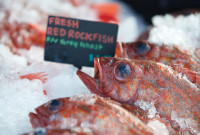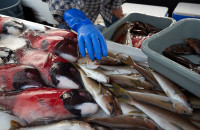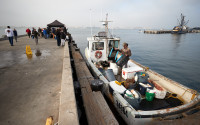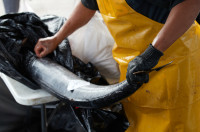Add seafood to your shelter-in-place menu and help our seafood industry weather the COVID-19 pandemic storm
While domestic fishing and aquaculture per se are not affected by the COVID-19 pandemic, the outbreak has had a big effect on the seafood industry. There has been a loss of both overseas markets and domestic buyers associated with the closure of restaurants and institutions under necessary “shelter in place” orders. The result has been reports of freshly harvested seafood piling up in boat holds, farms, and processing plant storage freezers with nowhere to go as the seafood supply chain screeches to a halt.
Other businesses that support fishing and aquaculture, but that are considered “non-essential” have had to halt operations which has affected processing and distribution of seafood, and the supply of needed materials such as fuel, ice, boat and gear parts.
In the longer term, there is uncertainty about the future of industry—which businesses, such as restaurants, will survive? Once the businesses along a food supply chain close, the supply chain breaks down and it cannot quickly or easily be started up again. There is concern that this gap in supply would quickly be filled by inexpensive imports, further increasing our seafood trade deficit.
The pandemic has created a crucial juncture for the US seafood industry, with the directions we head dependent upon how the industry is supported.




We could quickly lose ground in decades-long efforts to revitalize the country’s seafood industry-including the loss of a disproportionate number of small fishing and farming operations, which often don’t have the financial or social capital to adapt or weather the market fluctuations. Many groups will be vying for a finite amount of assistance, and seafood imports will carry on so that consumers, who are often content with inexpensive imports, will continue to get seafood resulting in the loss of many of valuable domestic fishing businesses.
This juncture also offers opportunities to local food systems. For example, direct marketing of local and diverse products could, out of necessity for safe local food, progress farther in a few months than it has over the last several or more years. Fishermen and farmers who are already engaged in direct marketing to consumers are selling out. Those who do not have direct connections and who have been selling all of their catch to buyers may not be doing as well since many of the buyers’ clients include restaurants and institutions, which are shut down now. Even marketing a small portion of one’s harvest seems to contribute to success of fishing and farming businesses- whether in times of crisis or not. And there are benefits to seafood processors and communities because of the increased supplies of fresh seafood and the consumer enthusiasm and demand that surround fishermen’s markets.
It’s a crucial time for whole communities, which include fishermen and aquafarmers, associated government and private groups, and the public, to organize and orchestrate efforts that put our producers first. The industry has quickly banded together to request assistance from the president and congress.
We as individuals or families can also help. Add seafood to your shelter-in-place menu!
- Buy directly from fishermen and aquafarmers at fishermen’s and farmer's markets, which are essential businesses. Check out our list of fishermen’s markets in California to find one near you.
- Check for local businesses that will deliver local food to your door. Read Edible San Diego’s How to support local San Diego without leaving home and check out Local Catch’s Seafood Finder mapping tool
- Check Google Maps for local restaurants that are open and offer take out
- When shopping in markets, ask for domestic seafood. If the fish is US caught then it is among the most sustainable in the world due to strict regulations that all fishermen follow.
Establishing strong local seafood supply chains will benefit us now and into the future, as a reliable source of safe, responsibly sourced seafood under “normal” conditions and to have it in place in the face of future crises. Read more: Local seafood availability and benefits
(Remember to follow distancing and hand-washing guidelines during and after your visit to a market.)
Read more about how the coronavirus crisis is affecting the US seafood industry and how we are responding.
- iNewsSource: California’s commercial fishing industry another victim of coronavirus
- Seafood Source: US seafood industry hopes for help from USD 2 trillion stimulus package
- California Sportsman: Fresh Seafood Still An Option Despite Coronavirus Concerns
- Los Angeles Times: Environmental groups urge Americans to eat more fish while hunkering down against virus
- ABC News 12: Fishermen return from sea with big catch, no place to sell
- Federal News Network: At sea during pandemic, fishermen return to stormy times
- North Atlantic Marine Alliance: Family food producers and anti-hunger advocates urge support for local supply chains in next stimulus bill (Press Release, PDF)
- Saving Seafood NCFC Thanks Senate for Support of American Businesses and Employees, and for $300 Million in Specific Fisheries Assistance
- KPBS Commercial fishermen struggle to survive in the face of coronavirus
Resources for fishermen, aquafarmers and others along the seafood supply chain
- Sea Grant Law Center CARES Resources
- NOAA Seafood Resources
- San Diego local food producer resources compiled by Sarah Shoffler, NOAA Southwest Fisheries Science Center (Google Doc)
- California Sea Grant Market Your Catch website
- National resources from the Sea Grant Fisheries Extension Network
- National Sea Grant Law Center: COVID-19 Resources
Written by California Sea Grant Extension Specialist Theresa Talley